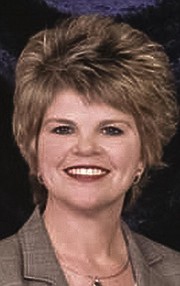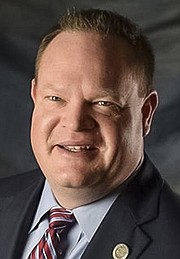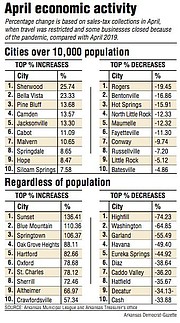Several Arkansas cities saw an economic boom in April -- a month in which travel was restricted and many businesses closed because of covid-19.
Sherwood Mayor Virginia Young said she was expecting a decline in city sales-tax revenue for April.
Instead, Sherwood had a 25.7% increase compared with April 2019.
"We were really surprised," said Young. "We were bracing for a decline, as I'm sure everyone was. We're very pleased. We just hope it continues."
Young attributes the April increase to people buying online.
[CORONAVIRUS: Click here for our complete coverage » arkansasonline.com/coronavirus]
"People are ordering from home," she said. "The Amazon Prime trucks are everywhere. We kind of feel like some of the things people stopped doing didn't affect us that much because we didn't have those venues."
Young described Sherwood as a "bedroom community" with only one hotel.
Sherwood's percentage increase was the biggest among cities with a population of 10,000 or more, according to the Arkansas Municipal League.
Cindy Frizzell, the league's finance director, said sales-tax collections have been closely monitored during the pandemic.
"Prior to covid-19, our municipalities were on a trajectory for an overall 6.95% increase in sale-tax distributions, but fell to an overall negative 2.58% for the June distributions (based on April sales)," she said in an email.
She was referring to distribution of sales-tax revenue from the Arkansas treasurer's office back to cities and counties, which happens two months after the taxes are collected.
The majority of Arkansas' 500 cities and towns have a city sales tax, said Whitnee Bullerwell, deputy director of the Municipal League. Many cities also have sales taxes that are collected only on hotels, restaurants and bars, with the revenue often going to fund advertising and promotions. This article, however, is about citywide sales-tax revenue, not including advertising-and-promotion taxes.
Mayors had been anxiously awaiting the April numbers. Gov. Asa Hutchinson implemented some travel and business restrictions in late March, but April would provide a better picture of economic activity during the pandemic because restrictions were in place for the entire month.
Among cities with more than 10,000 population, Rogers took the biggest hit, with April sales-tax revenue dropping by 19.5%, according to the Municipal League.
"I expected in the 22-to-24% range," said Rogers Mayor Greg Hines. "When you drove through the Promenade mall during that month, it looked like Christmas morning. Just vacant. This just highlights what I've said for many years is our economy in Rogers has shifted to a retail and entertainment base."
Hines said he expects Rogers to meet its revenue projections for the year. He said the city has $43 million in reserve, so he hasn't had to make the cuts other mayors have made.
"We may have the biggest dip in those numbers, but I guarantee you we have the least amount of angst," said Hines. "I'm in a bit of a unique position not having to run around like a chicken with my head cut off trying to figure out what to do financially and what to do about reopening."
Neighboring Bentonville was next in line, with sales-tax collections declining by 16.9%.
But Bella Vista, another nearby neighbor, had a 23.3% increase in sales-tax revenue, second only to Sherwood.
"Our collections were up thanks to online sales-tax collections, which we did not have last year at this time," said Cassi Lapp, a spokeswoman for Bella Vista. "But we also had increases in sales-tax collections in the building materials and grocery store sector. We attribute this to what we hear has been an increase in home remodel projects since people have been at home, plus the obvious ongoing need for groceries and supplies."
On July 1, 2019, Arkansas began requiring all online sellers to collect and remit state and local sales taxes. Before that, only sellers with a physical presence in Arkansas were required to collect and remit the taxes.
Hines said he's skeptical that online sales are providing that much of a boost in sales-tax numbers this year. He said some sellers may be collecting but not remitting the taxes to the state.
"I don't have an extreme degree of confidence that that's in place yet," Hines said.
Highfill -- population 583 -- had the biggest drop among all towns regardless of population. Sales-tax collections in Highfill fell by 74.2% in April compared with April 2019.
The Benton County town is home to the Northwest Arkansas Regional Airport. As the pandemic set in and air travel took a dive, passenger boardings at the airport dropped from 33,792 in March to 3,151 in April.
The airport accounts for the vast majority of Highfill's sales-tax revenue.
Highfill Mayor Michelle Rieff said she was braced for the decline in revenue.
"It was very obvious when we would drive by the airport and see the parking lot," said Rieff. "Every time I see a plane fly by, I say, 'Thank you, Jesus.'"
Rieff said she expects Highfill to lose $240,000 in sales-tax revenue this year because of the pandemic.
Because they collect less money in sales taxes, small towns saw the wildest swings in percentage changes for April. Tiny Sunset, population 198, in Washington County, had the biggest increase in Arkansas at 136.4%. Sunset collected $10,770 in April sales taxes, compared with $4,549 in April 2019, according to raw data from the Arkansas Department of Finance and Administration.
Ozark, in Franklin County, showed a 76% decline for April, but that was because of a clawback of earlier overpaid sales taxes, said Mayor Roxie Hall. So Ozark was omitted from the chart accompanying this article because its change didn't reflect only economic activity in April.
Mervin Jebaraj, director of the Center for Business and Economic Research at the University of Arkansas in Fayetteville, said he was surprised by the state sales-tax numbers.
"I and a lot of other people were expecting a much deeper hit, and we averted that," he said.
Jebaraj said the April economy was buoyed by the $1,200 federal stimulus checks and even more so by the extra $600 per week provided to unemployed people through the Coronavirus Aid, Response, and Economic Security Act.
The increased unemployment benefits are set to expire July 31. When that money runs out, it could be a very different story for the economy, said Jebaraj.
He cited research at tracktherecovery.org indicating spending by all consumers in the U.S. had declined by 7.4% from January to June 24. A chart on the website shows a 30% decline from January to early April, but spending has rebounded steadily since then.
Percentage-wise, low-income Americans haven't cut back on their spending as much as the wealthy, according to the research, which was done by Opportunity Insights, a nonpartisan, not-for-profit organization at Harvard University.
From January to June 24, high-income Americans cut their spending by 12.1%, compared with a 5.9% decrease for those with middle incomes and a 1.7% cut for people in the low-income category.
"While spending has rebounded over the last two months, especially for low-income households, spending among high-income households remains considerably lower than pre-covid-19 levels and appears to be connected to perceived health risks," according to the website.
Total spending in Arkansas increased by 4.2% from January to June 24, according to tracktherecovery.com.
High-income Arkansans cut spending by 8.5% during that period, while middle-income residents increased spending by 5% and low-income residents spent 4.2% more.
A breakdown of Arkansas spending changes by category from January to June 24 revealed these fluctuations:
• +20% for apparel and general merchandise.
• +13.8% for groceries.
• -53.3% on transportation.
• -44.4% for entertainment.
• -23.3% at restaurants.
• -1.3% for health care.




